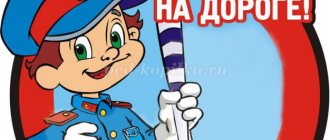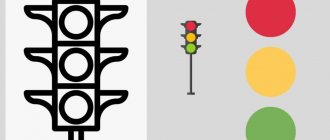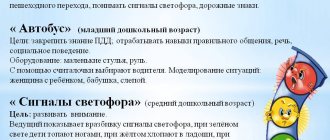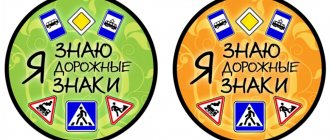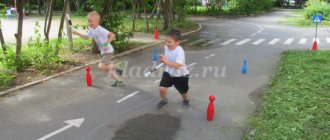Short-term project on traffic rules in the second junior group
Municipal autonomous preschool educational institution
Khorinsky kindergarten "Golden Key"
Project on traffic rules in the junior group “My friend is a traffic light”
Completed by: Mashanova Natalya Zhargalovna, teacher
Problem: children’s ignorance of traffic rules, rules of behavior on the street and on the road, traffic light signals. Justification of the problem: 1. Parents do not pay enough attention to the topic “Rules of behavior on the road”, “Rules of behavior on the street”, “Rules of the road”; 2. Children have no knowledge about the rules of behavior on the road, about changing traffic lights, and their meaning. Project type: educational and gaming. Project type: short-term
Project participants: children of the junior group “Pochemuchki”, teachers, parents. Goal: To develop safe behavior skills in children of primary preschool age through familiarization with traffic rules and safe behavior on the roads. Objectives: 1. To introduce children of primary preschool age to the rules of the road and traffic lights. Learn to understand the meaning of traffic light signals. Develop basic skills for safe behavior on the road and in the street. 2. Activate auditory and visual analyzers, develop speech, imagination and thinking in children. Fix the names of the colors (yellow, green, red). 3. Teach children to follow the rules and act in a team. 4. Activate the vocabulary: traffic light, green (red, yellow) color, steering wheel, safety, road, transport, sidewalk, roadway, shoulder, pedestrian crossing, intersection); Expected results: 1. Children have developed initial knowledge of traffic rules and safe behavior skills on the road and on the street. Children's interest in the topic. 2. Children take the initiative on their own: look at illustrations, participate in conversations, ask questions; show creativity, activity and detail in their work. 3.They enjoy drawing, sculpting, and playing various games. 4. Participation in joint activities of parents. Project activity product: Group and reception design; exhibition of children's works "Road and Traffic Light"; a city layout showing streets with sidewalks and roadways; transport traffic light layout. Project implementation:
1. Working with parents:
— consultation “Children on the roads”, “Is it easy to teach a child to behave correctly on the road”; — folder – movement “Teaching children traffic rules”, “Formation of street behavior skills in children”; — conversation “Start with yourself!”; — making a model of the village; — Questionnaire for parents “Be careful: the road!”; — Memo for parents “Everything starts small”; — Booklet for parents “In early preschool age, a child must learn”; — Recommendations “Formation of special skills in children”, “Teaching children the rules of safe behavior while walking and in a car.”
2. Working with children:
1. Review of material on the topic “Road Rules”, “My friend the traffic light”, “Rules of behavior on the road and on the street”, illustrations depicting vehicles, albums on the topic; 2. Conversation “My friend is a traffic light”; 3. Application “Traffic light”; 4. Reading poems, asking riddles on the topic “Traffic Rules”, “Traffic Light”; 5. Didactic games: “Road signs”, “Assemble the car in parts”, “Traffic light”, “Guess the transport”, “Assemble the car” (of 4 parts), puzzles; 6. Outdoor games: “Along a Long Winding Path”, “Sparrows and a Car”, “Train”, “Cars”, “Tram”, “Colored Cars”; 7. Role-playing game “Chauffeurs”, “Drivers and pedestrians”, “Transport” (multi-colored steering wheels, hats of different types of cars, badges, vests with the image of a particular type of transport), games with a layout; 8. Coloring pages for traffic rules; 9. View the presentation “Our friend the traffic light.” Result of the work: 1. Exhibition of crafts.
APPLICATIONS
Work with children.
Conversation with children “My friend is a traffic light” Purpose: To acquaint children with the basic rules of street traffic, tell them what irreparable consequences result from violating traffic rules. Teacher: How many cars are there on the streets?! And every year there are more and more of them. Heavy MAZs, KRAZs, GAZelles, buses are rushing along our roads, and cars are flying. In order to keep the roads safe, all cars and buses are subject to strict traffic laws. All pedestrians, adults and children, should know and follow the rules of behavior on the street. People go to work, to the store, kids hurry to school. Pedestrians should only walk on the sidewalk, but they should also walk on the sidewalk, keeping to the right. And then you won’t have to stumble, go around people you meet, or turn to the side. There are no sidewalks outside the city, and there are also a lot of cars. Transport moves along the roadway. If you have to walk along the road, then you need to walk towards the traffic. Why? It's not hard to guess. You see a car and give way to it, move to the side. You need to cross the road on a pedestrian path. Before crossing the road, you need to look to the left, and when you reach the middle of the road, look to the right. Our friend, the traffic light, helps us cross the road. Red light is a danger signal. Stop! Stop! - the red traffic light tells the pedestrian. Then the traffic light turns yellow. He says “Attention! Get ready! Now you can move on!” The green traffic light says: “The path is clear! Go! Teacher: The law of streets and roads, which is called “traffic rules”, is strict. He does not forgive if a pedestrian walks down the street as he pleases, without following the rules. And then an irreparable disaster happens. But the law of streets and roads is also very good: it protects from terrible misfortune, protects life. So that nothing happens to you, children, follow the basic rules of behavior: Do not cross the street in front of nearby traffic. Don't play outside close to the road. Do not sled, skate, or bike on the road. So, what children must learn in order to live peacefully in the world: 1. Walk only on the sidewalk, sticking to the right side. If there is no sidewalk, you need to walk along the left edge of the road, facing traffic. 2.Obey traffic light signals. Cross the street only when the traffic light is green. 3. Cross the road only on the footpath. You need to cross the street straight, not diagonally. 4.Before crossing the street, first look to the left, and when you reach the middle of the street, look to the right. 5. Cars, buses, trolleybuses must be walked around from behind, and trams - from the front. Application “Traffic Light” Objectives: continue to introduce the rules of behavior on the road, teach children to create an image of a traffic light from ready-made forms, consolidate the skill of gluing ready-made forms. Develop fine motor skills of the hands, visual attention, the ability to control and coordinate one’s actions. Expand and clarify vocabulary on the topic. Materials, tools, equipment. Cardboard, paper forms - yellow, green and red circles, glue, pencils, cloth napkins. Material for review. Contents of the lesson. The teacher reads the poem “Traffic Light” to the children. Then he draws up an image of a traffic light on a flannelgraph or magnetic board. Draws children's attention to the parts prepared for work. Clarifies the purpose of each traffic light color and why the traffic light is needed. Using the blank, children first draw a road for the cars (draw horizontal lines), and then make applications (stick on a traffic light from colored circles). After class. Design of the exhibition “Road and Traffic Light”. Reading poems. Poems and riddles Even though you have no patience - Wait, red light! Yellow light on the way - Get ready to go! Green light ahead - Now cross! *** Transition At the crossing strip On the side of the road, A three-eyed, lonely beast, Of a breed unknown to us, Talking to us with multi-colored eyes. The red eye is looking at us. “STOP!” says his order. A yellow eye is looking at us - CAUTION! And the green eye - For us: - POSSIBLE! This is how the Silent Traffic Light conducts its conversation. *** Standing from the edge of the street Wearing a long boot Three-eyed stuffed animal On one leg (traffic light). To help you pass the dangerous path, Both day and night are lit - Green, yellow, red (traffic lights). Here is the street, and the house, And the chimney on that house, Here is mom at the threshold, And leading to it... (road). Outdoor games “Along a long winding path” Goal: to teach walking along a cord calmly, slowly, without fear. Progress of the game: the teacher lays out a zigzag cord 5-6 m long on the floor - this is a path along which you need to walk to the end. At the end of the path, plant some interesting object. The task will depend on what is at the end of the path: go pet the bear, feed the bird, rattle the rattle. If someone is experiencing difficulties, help him, cheer him up. “Sparrows and a car” The child pretending to be a car is given a steering wheel. The rest of the children, playing the role of sparrows, wear hats with pictures of sparrows. The “sparrows” chirp and jump merrily. At the signal “Car!” they run away. The car drives and buzzes: “Beep.” “Train” Goal: to develop the ability to quickly respond to a signal, act together, and freely navigate the environment. Progress of the game Children line up in a column along one side of the playground or along the wall of the room. The first one standing in the column is a “locomotive”, the rest are “cars”. The presenter imitates the whistle of a steam locomotive, and the children begin to move forward (without a clutch), at first slowly, then faster and finally start running (while moving slowly they can make the sound “chu-chu-chu”). “The train is approaching the station,” says the presenter. The guys gradually slow down and stop. The presenter again imitates the whistle of the locomotive, and the movement of the “train” resumes. The teacher regulates the pace and duration of children's movements. It is recommended to use a guide in the game, for example, when the “train” goes over the “bridge” (on a gymnastic bench or on boards placed on steps or between two slats, drawn lines, placed laces, etc.). “Colored cars” Along the edges of the playground there are children with colored circles in their hands - these are steering wheels. The teacher is in the center with colored flags. He raises a flag of some color. Children with a circle of the same color run around the playground in any direction, honking, turning the circle like a steering wheel. When the flag goes down, everyone returns to their seats. Then the teacher raises a flag of a different color and other children run around. You can raise two or three flags at the same time, and then all the cars leave. “Cars” Each child receives a hoop. Children run around the playground, turning hoops and steering wheels left and right, trying not to interfere with each other. “Tram” Purpose: To teach children to move in pairs, coordinating their movements with the movements of other players; teach them to recognize colors and change movements according to them. Plot-role-playing game “We are drivers” Purpose. Introduce the profession - Driver. Expanding children's vocabulary. Cultivate interest and respect for the profession of a driver. Equipment: a bus made of chairs, a steering wheel, a driver’s cap, a pump, toy cars - a car, a truck. Progress of the game. A phonogram plays with the sounds of the street and the noise of cars. Educator. Guys, do you know what these sounds are? (Noise on the street). - What publishes them? (...
Pedagogical project “Road Rules”
Project type: creative and informational. Project duration: short-term. Project participants: teachers, preschool children, parents. The main direction of the project: prevention of children's road traffic injuries.
Relevance of the topic:
Very often, children are the cause of road accidents. This is caused by elementary ignorance of the basics of the Traffic Rules and the indifferent attitude of adults towards the behavior of children on the roadway. Another reason is that preschoolers do not yet sufficiently know how to control their behavior; they have not yet developed the ability to foresee possible danger, so they serenely run out onto the road. It is known that habits established in childhood remain for life, so studying the Rules of the Road is one of the main tasks today, and work on a project dedicated to the study of the Rules of the Road will contribute to this.
Goal: to develop in children the skills of safe, conscious behavior on the roads.
Tasks:
1. Teach children the necessary minimum of traffic rules and road signs. 2. Teach the child to competently use the acquired knowledge. 3. Increasing the competence of parents on issues related to traffic rules.
Stages: Preparatory Main Final.
Expected results:
1. By the end of the project, children will have developed knowledge of traffic rules and safe behavior skills on the road. 2. Create the necessary conditions for organizing the activities of preschool educational institutions to teach traffic rules to preschool children (subject-based developmental environment) 3. Arouse interest among parents in the problem of teaching children road literacy and safe behavior on the road. 4. Coordinate activities for parents to teach children traffic rules.
Stage 1 - preparatory:
1. Setting goals and objectives. 2. Determination of research methods. 3. Selection of visual and illustrative material. 4. Selection of fiction on the topic (riddles, poems). 5. Production of attributes for role-playing games. 6. Creation of didactic games. 7. Selection of material for productive activities. 8. Questioning parents.
Subject-based development environment for teaching children traffic rules: Toys and play equipment: bus, cars and trucks, dolls, strollers, “Transport” construction set. Traffic light, steering wheels, bag with tickets. The table is a model of a road with a pedestrian crossing, an intersection and city streets. There are small cars for it. Visual and didactic aids: poster on road safety, pictures of public transport: bus, train, taxi, cars and trucks. Pictures of a street showing the roadway and sidewalk. Pictures depicting various situations: cycling, sledding, children playing ball on the road. Illustrations showing a traffic light with a “Pedestrian crossing” sign. Pictures depicting all parts of cars (trucks and cars)
Stage 2 - main:
Carrying out a set of events on the topic: “Road Rules”. Includes: 1.Working with children 2.Working with parents
Working with children: Contents
1 Conversations: “How to cross the street correctly,” “We are pedestrians.” Conversation on the painting “City Street”. Examination of the poster “Rules of behavior on the road”, plot pictures and conversation on the topic “How to cross the street”. 2 Story games: “Garages and cars”, “Chauffeur”, 3 Didactic games: “Traffic light”, “Red, yellow, green”, “Assemble the traffic light”, “The fourth odd one”, “What is extra”, “Assemble the car” . 4 Reading fiction: S. Mikhalkov “If the light turned on red”, “Uncle Styopa is a policeman”. N. Migunova “Learning to cross the road.” poems, riddles about the rules of the road, etc. 5 Collective application “Cars are driving along the road”, application “Traffic light”, 6 Viewing the performance of the Kineshma Drama. Theater on traffic rules “About the cat Musya and grandmother Dusya” and a conversation on the content of the play. 7 Observations of passing cars while walking. 8 Outdoor games: “Sparrows and a car”, “Colored cars”.
Working with parents: Conversations with parents. Questioning. Increasing the competence of parents on issues related to traffic rules. Consultations for parents: “Road rules for preschoolers”
Stage 3 - final:
1. Exhibition of drawings and crafts on traffic rules. 2. Production of booklets “Know the rules of the road”, “Bicycles and safety”. 3. Preparation of instructions: “Teaching children to be observant on the street”, “Causes of children’s road traffic injuries”, “Rules of behavior at a bus stop”, “Rules for transporting children in a car”. 4. Generalization of positive experience. Providing results of work on the project.
QUESTIONNAIRE FOR PARENTS:
1. Do you introduce your child to the rules of the road? 2. At what age did you start introducing them to him? 3. Can you consider yourself a role model for following traffic rules? 4. It sometimes happens that your child “teaches” you a lesson in how to behave safely on the road.
Bibliography:
Avdeeva N.N., Styorkina R.B. "Safety". - St. Petersburg: “Childhood - Press”, 2004.–144 p. Belaya K.Yu., Zimonina V.N. How to ensure the safety of preschoolers. - M.: “Enlightenment”, 2000, edition 2, – 94 p. Belaya K.Yu., Zimonina V.N. Your safety. - M.: “Enlightenment”, 2000, 2nd edition, – 48 p. Izvekova N.A., Medvedeva A.F. Classes on traffic rules. - M.: LLC "TC Sfera", 2009 - 64 p. Klimenko V.R. Teach preschoolers the rules of movement. - M.: “Enlightenment”, 1973 - 48 p. Kozlovskaya E.A. Prevention of children's road traffic injuries. - M.: Third Rome Publishing House, 2008 - 55 p. Komarova L.G. We build from Legos. - M.: Linko-Press LLC, 2001 - 89 p. Nesterenko A.A. Country of mysteries. – Rostov n/d.: Publishing house – in Rost. Univ., 1991. Rublyakh V.E. Traffic rules. - M.: “Education”, 1984, edition 9 – 48 p. Saulina T.F. Three traffic lights. - M.: “Enlightenment”, 1989 – 64 p. Startseva O.Yu. School of Road Sciences. - M.: LLC "TC Sfera", 2009, edition 2–64 p. Cherepanova S.N. Traffic rules. - “Scriptorium Publishing House 2003”, 2008 – 80 p. Shurygina T.A. Cautious tales. - M.: “Knigolyub”, 2002 – 80 p.
Results achieved: children have basic knowledge of traffic rules and the need to comply with traffic regulations.
Author: Olga Lvovna Rumyantseva, teacher, MKDOU TsRR d/s No. 1, Ivanovo region, Zavolzhsk, Russia
The article is published in the author's edition
